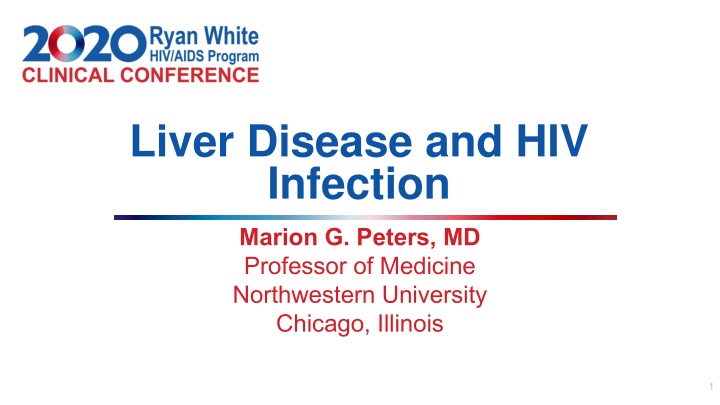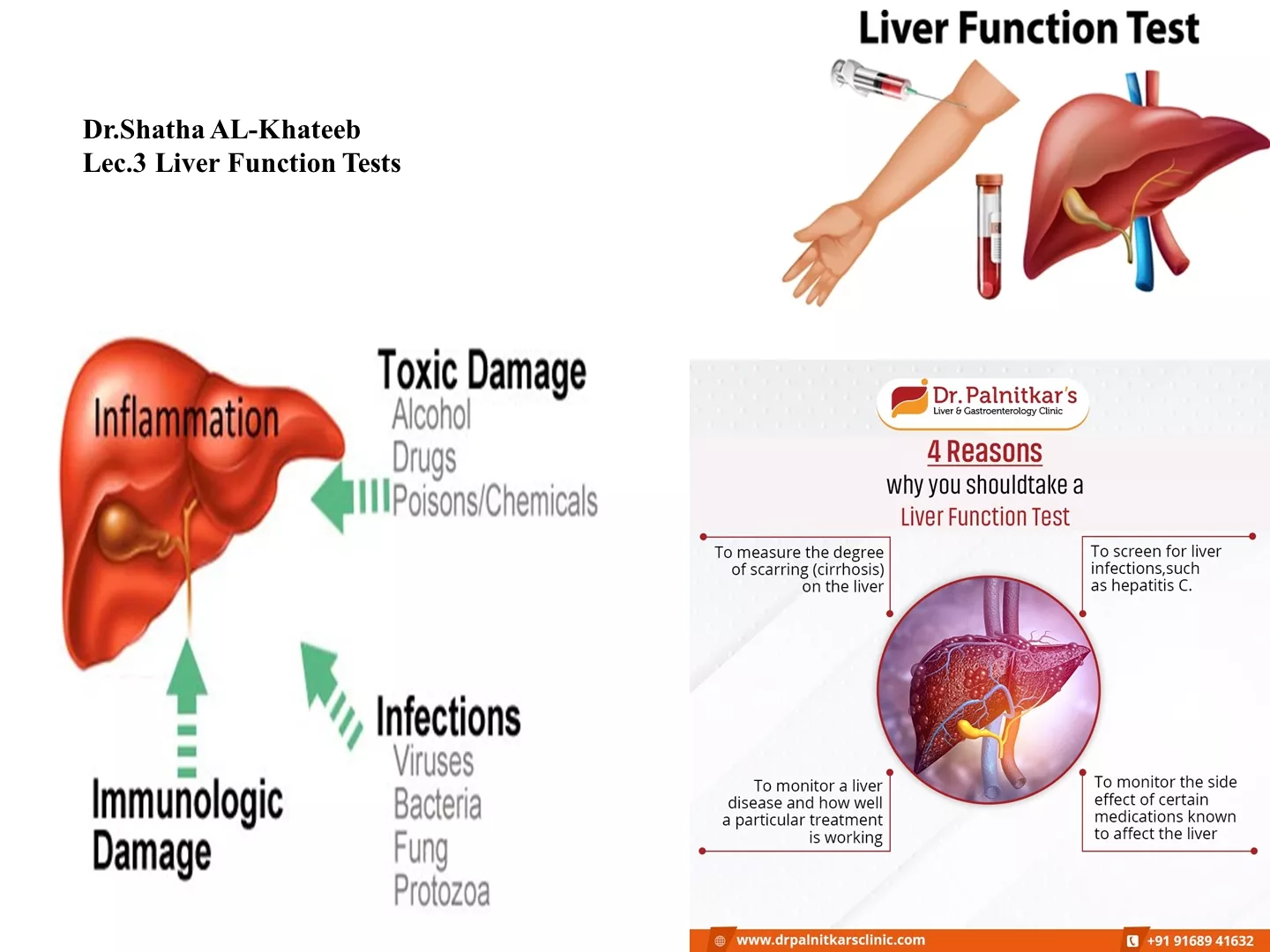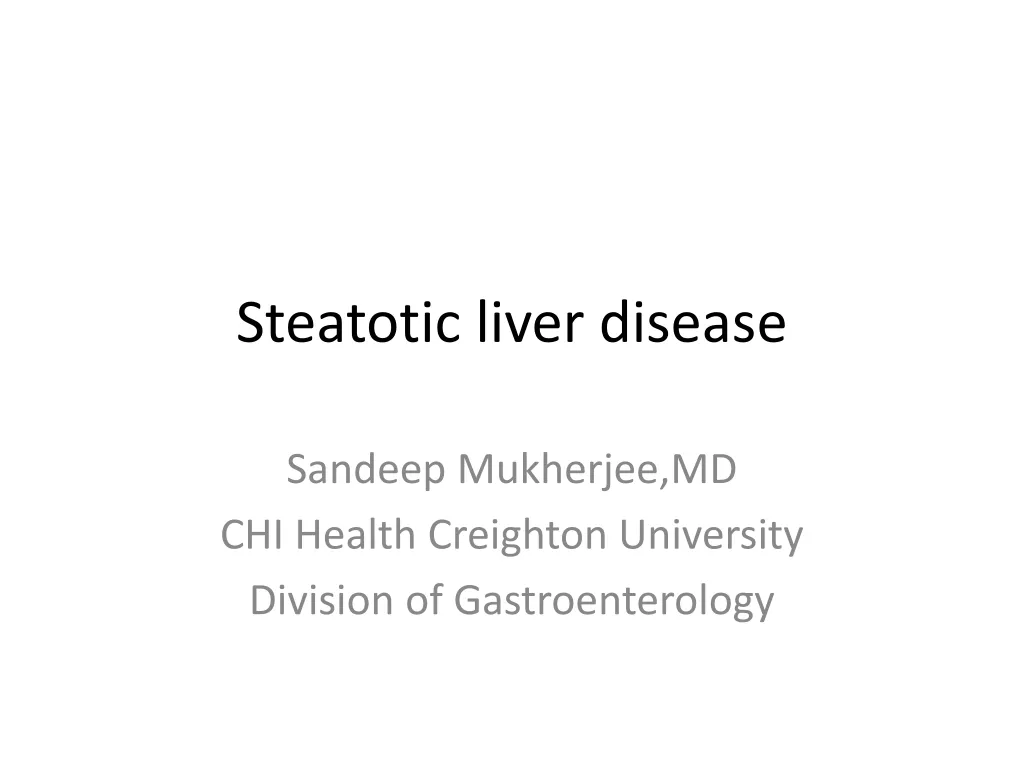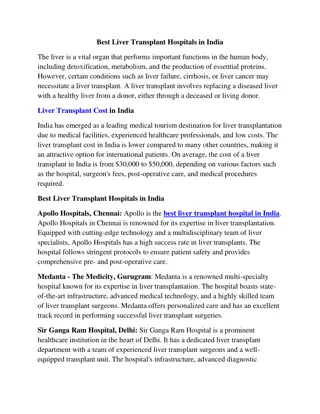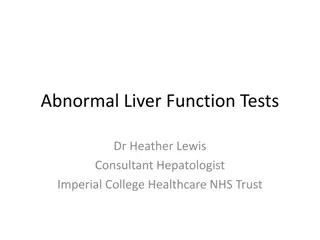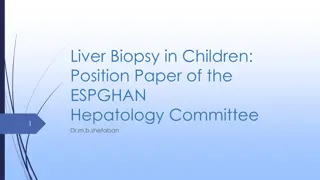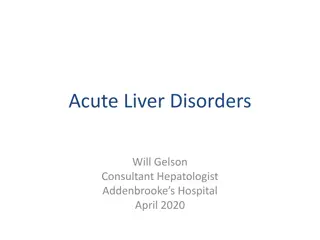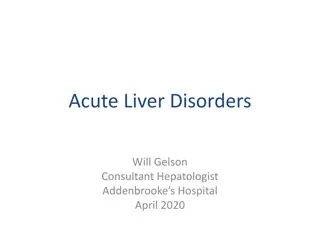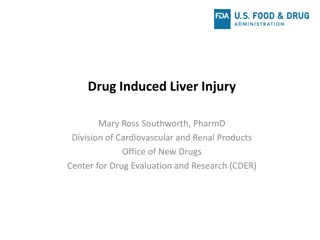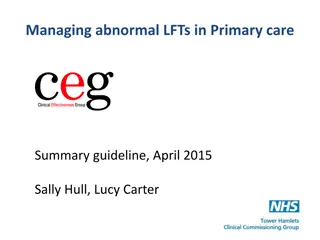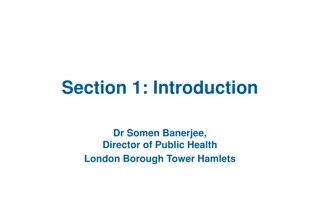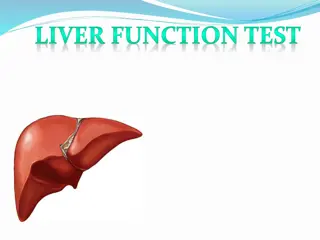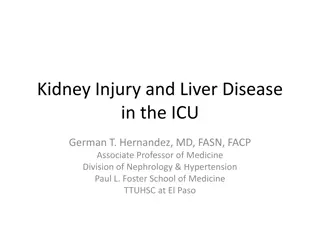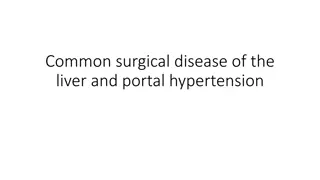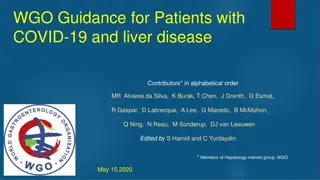Liver Disease and HIV Infection by Marion G. Peters, MD
This presentation by Dr. Marion G. Peters discusses liver disease in individuals living with HIV, covering causes, evaluation of abnormal liver tests, and outcomes with HBV. The slides provide insights into common liver diseases, evaluation of abnormal LFTs, and the impact of HIV coinfection on liver-related mortality.
Download Presentation

Please find below an Image/Link to download the presentation.
The content on the website is provided AS IS for your information and personal use only. It may not be sold, licensed, or shared on other websites without obtaining consent from the author.If you encounter any issues during the download, it is possible that the publisher has removed the file from their server.
You are allowed to download the files provided on this website for personal or commercial use, subject to the condition that they are used lawfully. All files are the property of their respective owners.
The content on the website is provided AS IS for your information and personal use only. It may not be sold, licensed, or shared on other websites without obtaining consent from the author.
E N D
Presentation Transcript
Liver Disease and HIV Infection Marion G. Peters, MD Professor of Medicine Northwestern University Chicago, Illinois 1
Financial Relationships With Commercial Entities Dr Peters has served as an advisor to Abbott, Antios, Aligos, and Atea. Her spouse is employed by Hoffman- La Roche. (Updated 7/30/20) Slide 2 of 31
Learning Objectives After attending this presentation, learners will be able to: Describe most common causes of liver disease in people living with HIV (PLWH) Determine how to evaluate abnormal liver tests in PLWH Discuss new issues with HBV, HCV and fatty liver disease in PLWH Slide 3 of 31
Liver Disease in PLWH Necro-inflammation Stellate cell activation HCV / HBV Other Liver Diseases Alcohol Drugs Medications Drug-related Hepatotoxicity Fibrosis NAFLD Cirrhosis Antibiotics; TB, fungal, bacterial NSAIDS Neuropsychiatric medications OTC e.g. herbal medications HAART HIV Slide 4 of 31
Evaluation of Abnormal LFTs in PLWH Evaluation of Abnormal LFTs in PLWH Liver Tests: -Function: Albumin, bilirubin, INR -Cholestasis: Alk Phos, bilirubin Common liver diseases: HBV: HBsAg, anti-HBs, anti-HBc HCV: HCV Ab, HCV RNA NAFLD: Fasting glucose, TG, cholesterol, Hgb A1c Less common Metabolic: Iron, Tsat, ferritin (hemochromatosis), Ceruloplasmin (Wilson Disease) Autoimmune diseases: AMA, IgM (for PBC), ASMA, ANA, IgG (for AIH) A1AT phenotype Hepatotoxicity -Inflammation: AST, ALT -portal HTN: platelets, WBC -alcohol -drug toxicity Fibrosis: APRI: AST/Platelet ratio; FIB-4 (AST, ALT, plt, age); Fibroscan, ARFI (ultrasound) Liver biopsy Imaging only if PHTN Vaccination status for HAV (IgG) and HBV Liver imaging and fibrosis assessment Slide 5 of 31
Worse outcomes with HBV Worse outcomes with HBV- -HIV coinfection HIV coinfection HIV HBV vs HBV higher % HBeAg positivity Lower loss of HBsAg after acute infection (79% vs >95%) higher HBV DNA levels longer duration of viremia lower aminotransferase levels more rapid progression to cirrhosis HIV HBV vs HIV 14-fold higher liver-related mortality higher risk of progressing to AIDS or death Thio 2002; Konopnicki 2005; Hoffmann 2009; Chun 2012 Slide 6 of 31
HBV HBV- -HIV still a problem in this decade HIV still a problem in this decade Analysis of 72,584 HBV; 133,880 HIV; and 8,155 HBV/HIV Compared to HIV monoinfection Higher liver related admissions: HBV/HIV patients (48%) vs HIV (28%, P<0.001) Compared to HBV monoinfection HBV/HIV higher liver-related mortality (OR 1.73, 95% CI 1.20-2.48) HBV/HIV higher all cause mortality (OR 1.50, 95% CI 1.10-2.04) Longer length of stay HBV/HIV (+1.41 days, 95% CI 0.84-1.99) 2011 US Nationwide Inpatient Sample 214,621 HBV+ patients: Rajbhandari JVH 2018 Slide 7 of 31
Treatment of HBV HIV Treatment of HBV HIV ART including agents with activity against HIV and HBV is recommended for all patients co-infected with HIV and HBV, regardless of CD4 cell count or need for HBV treatment ART must include two drugs active against HBV, preferably tenofovir and emtricitabine, regardless of the level of HBV DNA. Such a regimen will reduce the likelihood of immune reconstitution inflammatory syndrome (IRIS) against HBV reduce risk of resistance which could occur with newer regimens without HBV active drugs or with 3TC or FTC alone Slide 8 of 31 DHHS Guidelines 2017
With current therapies HBsAg loss in HBV monoinfection is a high bar Not head-to-head trials; different patient populations and trial designs Extended Treatment With Nucleos(t)ide Analogues* vs 1 Yr Peginterferon Treatment HBeAg positive 100 80 Entecavir Tenofovir Peginterferon HBsAg Loss (%) 60 TDF +PEG 1y 9.3% 37.5% had geno A 40 20 8 8 6 6 5 5 3 2 NA 0 1.0 Yr 1.5-2.0 Yrs 3.0-4.0 Yrs *With sustained undetectable HBV DNA. Chang TT, et al. N Engl J Med. 2006;354:1001-1010. Marcellin P, et al. N Engl J Med. 2008;359:2442-2455. Buster EH, et al. Gastroenterology. 2008;135;459-467. Gish R, et al. Gastroenterology. 2007;133:1437-1444. Heathcote J. AASLD 2008. Abstract 158. Heathcote J, et al. AASLD 2009. Abstract 483. Janssen HL, et al. Lancet. 2005;365:123-129; Marcellin Gastro 2016 Slide 9 of 31
With current therapies HBsAg loss is a high bar Not head-to-head trials; different patient populations and trial designs Extended Treatment With Nucleos(t)ide Analogues* vs 1 Yr Peginterferon Treatment HBeAg positive 100 80 Entecavir Tenofovir Peginterferon HBsAg Loss (%) 60 TDF +PEG 1y 9.3% 37.5% had geno A 40 20 8 8 6 6 5 5 3 2 NA 0 1.5-2.0 Yrs 3.0-4.0 Yrs 1.0 Yr *With sustained undetectable HBV DNA. Chang TT, et al. N Engl J Med. 2006;354:1001-1010. Marcellin P, et al. N Engl J Med. 2008;359:2442-2455. Buster EH, et al. Gastroenterology. 2008;135;459-467. Gish R, et al. Gastroenterology. 2007;133:1437-1444. Heathcote J. AASLD 2008. Abstract 158. Heathcote J, et al. AASLD 2009. Abstract 483. Janssen HL, et al. Lancet. 2005;365:123-129; Marcellin Gastro 2016 Slide 10 of 31
Loss of HBsAg in HIV/HBV with ART therapy Loss of HBsAg in HIV/HBV with ART therapy Country Zambia N 284 % HBsAg loss 10.2 % at 2 years Predictor BL CD4 < 350 OR 4.94 (1.02-23.8) Reference Chihota et al JID 2020 Germany 359 18% median 4 yrs Less robust CD4 response associated with non- seroconversion Boesecke et al CROI 2019 CROI 2019: not clear if adult acquired (20% chronic) HBV or perinatal (95% chronic) Increase in clearance with ART- Matthews Slide 11 of 31
(6/47) Matthews Plos One 2013 Slide 12 of 31
ART as HBV ART as HBV PrEP PrEP: HBV : HBV- -Free Survival in MSM Free Survival in MSM HBV-active treatment, with TDF log-rank 100 Cumulative HBV free Survival (%) P=0.004 HBV-active treatment, no TDF 80 P<0.001 No treatment 60 40 2470 tested for HBV immunity vaccinated 381 failed vaccination pre ART 33 incident HBV infections 20 log rank P < 0.001 0 days 0 2000 4000 6000 Numbers in Observation No Treatment Treatment, No TDF Treatment, with TDF 19 36 38 107 86 189 50 67 49 8 16 12 Slide 13 of 31 Heuft and Brinkman K, AIDS 2014
HBV in PLWH Summary HIV increases HBV chronicity after acute HBV infection HBV increases antiretroviral-related hepatotoxicity HIV/HBV coinfection increases the risk of end stage liver disease compared to HBV alone Tenofovir based therapy can be HBV PrEP ART can lead to loss of HBsAg especially in first 1-2y Screen all HBV patients for HCC not just those with severe fibrosis There are new drugs on the horizon (Virologic failures may indicates poor adherence) (Reactivation of HBV can occur with immune suppression) Thio CL, et al. Lancet. 2002: Koziel NEJM 2007; Rajbhandari J Viral Hepat 2016 Slide 14 of 31
HCV in PLWH HCV in PLWH DAA are highly effective in HIV/HCV co-infection Treatment of HCV is same regardless of HIV but Drug-drug interactions greater, esp with NS3 PI containing regimens TDF regimens appears safe with LDV/SOF, SOF/VEL Switch of ARVs prior to DAA therapy - likely safe and effective- Early treatment of acute HCV is successful Reinfection can occur HCV cure improves survival (liver, AIDS, all cause), renal dz and diabetes stable Slide 15 of 31 HCVguidelines.org
Lower Mortality after SVR in HIV HCV Lower Mortality after SVR in HIV HCV Overall Mortality Liver-related Death Slide 16 of 31 Gesida cohort Berenguer CID 2012
Lower Mortality after SVR in HIV HCV Lower Mortality after SVR in HIV HCV Lower AIDS-defining conditions: P = .003 Lower non-liver-related deaths: P = .002 Lower non-liver-related, non-AIDS-related deaths: P = .002 5 y follow up: SVR associated with Significant decrease in diabetes mellitus (sHR 0.57[95% CI, 0.35 - 0.93] P = .024) Decline in chronic renal failure (sHR 0.43 [95% CI, 0.17 - 1.09], P =.075 Overall Mortality Liver-related Death Slide 17 of 31 Gesida cohort Berenguer CID 2012; Hepatology 2017
Predictors of HCC post HCV SVR Predictors of HCC post HCV SVR 33,005 VA patients; 10,827 SVR Incidence rate of No SVR SVR to IFN-based Rx 100 new HCC cases 1.32% per year 0.33% per year OR (CI) 6.69 (4.3-10.4) P value <0.0001 Cirrhosis at SVR Age >65 4.51 (2.0-10.4 ) 0.004 Age 55-64 y 2.04 (1.3-3.2 ) 0.002 Hispanic vs Cauc 2.3 (1.1-4.8 ) 0.03 DM 1.80 (1.2-2.9) 0.005 Alcohol 1.68 (1.08-2.60) 0.02 Slide 18 of 31 El-Serag. Hepatology. 2016
Post Post- -HCV cure f HCV cure follow ollow- -up depend on pre Rx Fibrosis Stage up depend on pre Rx Fibrosis Stage Assess Pre-treatment Fibrosis Stage PRE Advanced Intermediate Low F0-1 F3-4 F2 POST Long-term follow-up No further monitoring needed; release back to PCP Regress Progress Monitor for progression to advanced fibrosis Surveillance for HCC Varices Slide 19 of 31
HCV: Incident Infection Treatment as prevention HCV: Incident Infection Treatment as prevention /100 PY 40 all 1.5 MSM N new acute HCV genotype 4 Other risk groups genotype 1 P=0.001 30 1.0 20 0.5 10 P=0.010 All 0 0.0 T1 2014 T2 2014 T3 2014 T1 2016 T2 2016 T3 2016 T1 2017 0 2012 2013 2014 2015 2016 HCV incidence is still increasing in French HIV- infected MSM. Cotte Liver International 2018 Declining HCV incidence in Dutch HIV+ MSM after unrestricted access to HCV therapy. Boerekamps et al. Clin Inf Dis, 2018 Slide 20 of 31
HCV: Reinfection and spontaneous clearance HCV: Reinfection and spontaneous clearance THE 100% HCV Ab is not protective Reinfection can occur Germany: GECCO 9 9.02/100py in MSM; 1.14/100py in PWIDS Madrid: 5.93 per 100 patient-years in MSM Canada: 3.1 per 100 patient- years active PWID Spontaneous clearance after acute HCV is lower in PLWH 88.1% PROBE-C STUDY 80% 60% 40% 20% 11.9% 409/464 55 0% SC PV persistent viremia HCV/HIV: spontaneous clearance SVR: 75.6% (245/324); Reinfections: 17% (51/300) Inglitz CID 2019; Berenguer AIDS 2019; Rossi JHEP 2018: Boesecke et al. CROI 2018 Slide 21 of 31
Concomitant Liver Disease Concomitant Liver Disease HIV-related Prospective Longitudinal cohort N=275, HIV/HCV and HCV >95% with liver bx prior to treatment After SVR abnormal LE in ~12% overall 20% in PLWH Risk factors for LE elevation HIV (ARV toxicity) Steatosis ETOH Statin use Severe fibrosis/cirrhosis Immunosuppression Antiretrovirals (NNRTIs, NRTIs, or PIs) Opportunistic infection Immune reconstitution Pro-inflammatory state Insulin resistance Dyslipidemia Microbial translocation Host Alcohol use Older age BMI/central obesity Insulin resistance Non-alcoholic fatty liver disease Medications HBV co-infection Steatosis Necro- inflammation Stellate cell activation HCV-related Insulin resistance Pro-inflammatory state Fibrosis Cirrhosis Hadigan et al, 18th Int Workshop on Comorbidities and Adverse Drug Reactions in HIV, Sep 2016, New York. Abstract O024; Naggie & Sulkowski, Gastro 2012 Slide 22 of 31
HCV Summary in PLWH HCV Summary in PLWH Many benefits of HCV cure: liver and non-liver- systemic inflammation Those with F3/4 pre-treatment need HCC monitoring post-SVR Imaging and alfa fetoprotein q 6months Need to stage fibrosis pre-treatment to optimally monitor post- cure Concurrent alcohol or fatty liver places patients at risk for future cirrhosis oMonitor for fibrosis progression in these patients Counsel healthy liver practices for all- alcohol, drugs, diet, lifestyle, MS Monitor for reinfection in at-risk patients Discuss reinfection risk with patient Slide 23 of 31
NAFLD in the general population NAFLD in the general population and high risk groups and high risk groups NAFL: non alcoholic fatty liver Fat Steatohepatitis: NASH Fat Inflammation +/- Fibrosis Cirrhosis HCC General Population NAFLD 30% NASH 2-5% Obesity Type 2 Diabetes NAFLD 75% NAFLD 60% NASH 35% NASH 50% Slide 24 of 31
Risk Factors Risk Factors Metabolic Syndrome Obesity/central adiposity Insulin resistance Hypertriglyceridemia Hypertension Emerging associations: Hispanic ethnicity Hereditary/genetic (PNPLA3) Polycystic ovary syndrome (PCOS) HIV Sleep apnea Hypothyroidism NAFLD is the hepatic manifestation of the metabolic syndrome Bedogni, Hepatology, 2005. Chalassani, Hepatology 2012. Slide 25 of 31
Primary NAFLD vs HIV Primary NAFLD vs HIV- -associated NAFLD associated NAFLD Primary NAFLD HIV-associated NAFLD NAFLD Prevalence ~30%, varies by study 35%, HIV not independent risk factor Obesity, type 2 diabetes, dyslipidemia, metabolic syndrome, hereditary/genetic Obesity, type 2 diabetes, dyslipidemia, metabolic syndrome, hereditary/genetic NAFLD Risk Factors NAFLD at lower BMI lean NASH HIV-specific: older NRTI s, D-drugs , early generation PI s, lipodystrophy 25-30% of NAFLD patients with liver biopsy 42% of NAFLD patients with liver biopsy NASH Prevalence 35-40% progress 1 stage in 7 yrs for NASH Fibrosis Progression 1 stage 5y (1 study 30 pts)* Increased CVD risk Increased liver-related and all-cause morality Emerging evidence of independent a/w CVD, scant data on long-term outcomes Long-term outcomes Determine liver fibrosis: FIB-4 (AST, ALT, plt, age); Nash Fibrosis score (age, BMI, hyperglycemia, plt, alb, AST/ALT Determine inflammation: liver biopsy; abnormal ALT (47% had NASH, Lemoine JAIDS 2019) *Stanley Lancet HIV 2019 Slide 26 of 31
Management options Management options -CAD 1o cause of death in NAFLD -25% major CV events have NAFLD Lifestyle Change Diet Exercise lose fat Bariatric Surgery Resolves NASH 85% Less fibrosis 33% Treat Metabolic Syndrome Hypertension Dyslipidaemia T2DM Control Obesity Reduce CVD Risk Metformin Simvastatin Safe in liver dz Potential effects for HCC Chemoprevention Reduce HCC Risk Vitamin E (not DM F4) Pioglitazone (wt gain) Trials: includeTesamorelin (GHRH), FXR agonists (OCA), CCR2/5 antagonists (cenicriviroc), PPAR FGF19 and GLP-1 agonists Targeting NASH Promrat et al, 2010; Thoma et al, 2012; Vilar-Gomez et at, 2015; Lassailly et al, 2015; Ratziu et al, 2010; Musso et al, 2010; Sanyal et al, 2010; Lavine et al, 2011; Cusi et al, 2016; Armstrong et al, 2012; Zhang et al 2012; Chen et al 2013; El-Serg et al, 2009; Singh et al 2013; Stanley Lancet HIV 2019 Slide 27 of 31
Summary of NAFLD in PLWH Summary of NAFLD in PLWH NAFLD is an umbrella term that includes NAFL and steatohepatitis (NASH) NAFLD is common in PLWH NASH (inflammation +/- fibrosis) higher progression to cirrhosis Biopsy is needed to diagnose NASH NASH is higher in PLWH Steatogenic and fibrotic effects of HIV/ART likely impact the natural history PLWH at higher risk for lean NAFLD (45% in one series) NAFLD Prevalence is likely to increase with aging HIV+ population Main risk factors are metabolic, genetic/hereditary Leading cause of death in NAFLD: CAD NAFLD is an important contributor to HCC incidence and need for liver transplant Management hinges on weight loss, exercise, avoiding added carbohydrates, metabolic syndrome control Slide 28 of 31
Hepatocellular carcinoma in PLWH Hepatocellular carcinoma in PLWH Increasing prevalence of HCC with longer life span Viral hepatitis, ETOH and NAFLD most common cause of cirrhosis Treatment of viral hepatitis decreases fibrosis/cirrhosis and risk of HCC But HCC can occur after HCV cure HCC occurs in younger PLWH with likely worse survival Essential to diagnose cirrhosis- Fibroscan, APRI, FIB-4, imaging if PHTN Screen all HBV patients (HCC can occur without F3-4) and all cirrhotics Screening and early diagnosis critical for optimal therapy Access to therapies includes locoregional therapy and liver transplant Slide 29 of 31
Liver Disease in PLWH Liver Disease in PLWH There is a lot of liver disease in HIV persons HCV can be treated and can recur HBV: new drugs in pipeline NALFD major new disease requiring diagnosis and management of metabolic syndrome While viral hepatitis, alcohol and NAFLD are most common, abnormal LFTs should be evaluated as in HIV negative persons Less hepatotoxicity with newer ART With longer life span Increasing morbidity and mortality from liver disease Increased HCC- so need to determine amount of fibrosis Slide 30 of 31
Thank you Thank you Slide 31 of 31
Question Question- -and and- -Answer Session Answer Session
